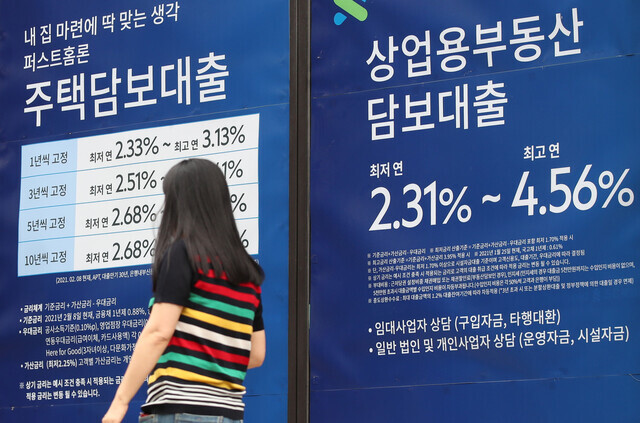hankyoreh
Links to other country sites 다른 나라 사이트 링크
S. Korea’s household debt may soon surpass annual target growth rate

In September, the total amount of loans owed by households to banks rose to more than 95 trillion won (US$79.8 billion). This represents a rate of increase of 5.8% — close to the government’s annual target growth rate of 6% or lower.
The country’s financial regulator, the Financial Services Commission (FSC), released a report on Wednesday entitled “Trends in Household Loans, September 2021” that found that total household loans in September had grown by 7.8 trillion won (US$6.5 billion) compared to August. This was slightly lower than the amount of increase for household loans in August, which was recorded as 8.6 trillion won (US$7.2 billion).
Meanwhile, the report found that household mortgages, jeonse (key money) loans, and group loans had increased by 6.7 trillion won (US$5.6 billion). This was a slight decrease compared to the increase of 7.1 trillion won (US$5.9 billion) seen in August. The 800 billion won (US$672 million) increase in credit loans was also lower than the increase of 1.3 trillion won (US$1 million) in August. According to the FSC, Chuseok holiday bonuses led to a decrease in personal credit-based loans and credit card loans through specialized credit finance companies.
In the banking sector alone, household loans in September increased by 6.5 trillion won (US$5.4 billion). Most of this increase in household debt was due to jeonse loans (2.5 trillion won, or US$2.1 billion) and group lending (1.5 trillion won, or US$1.2 billion).
The FSC found that the total amount of household debt owed to banks grew by 95.3 trillion won (US$80.06 billion) from January to September. Households took out 1.63 quadrillion won (US$1.36 trillion) in loans as of late last year, which means that household loans increased by 5.8% as of September.
Given that the increase in household loans was just 5.3% from January to August, this means the 0.5% increase happened in the space of just a month. If the government does not take measures to reduce household loans over the three remaining months of the year, it is highly likely that the growth in household debt will surpass the FSC’s goal for this year of 6% year-on-year growth.
“The financial authorities are currently working on additional measures intended to curb the household debt growth. The authorities will ensure that the measures address the needs of lower-income groups,” the FSC said in a press release.
By Lee Kyung-mi, staff reporter
Please direct questions or comments to [english@hani.co.kr]

Editorial・opinion
![[Correspondent’s column] The real reason the US is worried about Chinese ‘overcapacity’ [Correspondent’s column] The real reason the US is worried about Chinese ‘overcapacity’](https://flexible.img.hani.co.kr/flexible/normal/500/300/imgdb/original/2024/0510/5217153290112576.jpg) [Correspondent’s column] The real reason the US is worried about Chinese ‘overcapacity’
[Correspondent’s column] The real reason the US is worried about Chinese ‘overcapacity’![[Editorial] Yoon’s gesture at communication only highlights his reluctance to change [Editorial] Yoon’s gesture at communication only highlights his reluctance to change](https://flexible.img.hani.co.kr/flexible/normal/500/300/imgdb/original/2024/0510/7717153284590168.jpg) [Editorial] Yoon’s gesture at communication only highlights his reluctance to change
[Editorial] Yoon’s gesture at communication only highlights his reluctance to change- [Editorial] Perilous stakes of Trump’s rhetoric around US troop pullout from Korea
- [Guest essay] Preventing Korean Peninsula from becoming front line of new cold war
- [Column] The state is back — but is it in business?
- [Column] Life on our Trisolaris
- [Editorial] Penalties for airing allegations against Korea’s first lady endanger free press
- [Editorial] Yoon must halt procurement of SM-3 interceptor missiles
- [Guest essay] Maybe Korea’s rapid population decline is an opportunity, not a crisis
- [Column] Can Yoon steer diplomacy with Russia, China back on track?
Most viewed articles
- 1[Correspondent’s column] The real reason the US is worried about Chinese ‘overcapacity’
- 2S. Korea “monitoring developments” after report of secret Chinese police station in Seoul
- 3Nuclear South Korea? The hidden implication of hints at US troop withdrawal
- 4[Book review] Who said Asians can’t make some good trouble?
- 5‘We must say no’: Seoul defense chief on Korean, USFK involvement in hypothetical Taiwan crisis
- 6Presidential office warns of veto in response to opposition passing special counsel probe act
- 7[Editorial] Perilous stakes of Trump’s rhetoric around US troop pullout from Korea
- 8In Yoon’s Korea, a government ‘of, by and for prosecutors,’ says civic group
- 9[Editorial] Yoon’s gesture at communication only highlights his reluctance to change
- 10Korean firms cut costs, work overtime amid global economic uncertainties